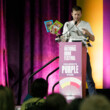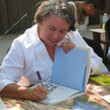Dory Fantasmagory
(Libby/OverDrive eAudiobook)
Available Platforms
Description
More Details
Excerpt
Similar Series From Novelist
Similar Titles From NoveList
Similar Authors From NoveList
Published Reviews
Booklist Review
A little sister causes all kinds of trouble in Hanlon's debut chapter book. Aimed at beginning readers, it is narrated by six-year-old Dory, whose chief goal in life is to be invited to play with her older brother and sister. Of course, they don't want to play with her because she acts like such a baby, asks constant questions, and plays with imaginary creatures. Indeed Dory has such a vivid imagination that the black-and-white illustrations often picture what Dory believes is happening, not what the rest of the family is experiencing. Young readers may or may not identify with Dory, whose antics annoy even her mother (like when Dory persists in pretending to be a puppy at the doctor's office), but they will better understand another child's intense need for attention. In both words and pictures, Hanlon succeeds in getting inside Dory's head and it's pretty lively in there.--Nolan, Abby Copyright 2014 Booklist
Publisher's Weekly Review
Dory's nickname, "Rascal," is an immediate tip-off to the six-year-old's personality, but there's more to Dory than just being a spitfire. To combat her older siblings' refusal to play with her because she's a "baby," Dory conjures up Mary, a monster friend who appreciates her incessant questions, like "Why do we have armpits?" and "What is the opposite of sandwich?" Dory's pestering leads Luke and Violet to tell her that 507-year-old Mrs. Gobble Gracker, "who robs baby girls," is looking for her. This sets Dory's imagination spinning, leading to the appearance of the vampiric Mrs. Gobble Gracker and the gnomelike Mr. Nuggy, who introduces himself as her fairy godmother. Reality and fantasy combine hilariously in a story that, at heart, is about a girl who wants little more than to spend time with her brother and sister. Hanlon's (Ralph Tells a Story) loosely scrawled illustrations, speech balloons, and hand-lettering are an enormous part of the story's humor, channeling Dory's energy and emotions as emphatically as the narration. Time spent with Dory is time well spent. Ages 6-8. Agent: Ann Tobias, A Literary Agency for Children's Books. (Oct.) © Copyright PWxyz, LLC. All rights reserved.
School Library Journal Review
Gr 1-3-Six-year-old Dory has a very fantasmagory imagination, much to the dismay of her two older siblings. Summer break has begun and the multiple, pesky attempts by Dory to join in the family fun are repeatedly rejected. Exasperated, Violet and Luke conspire to teach Dory a lesson; they invent the terrifying 507-year-old Mrs. Gobble Gracker who steals baby girls and is now looking specifically for Dory! However, with the aid of her (invisible) friends-Mary and Mr. Nuggy, the fairy godmother-Dory thwarts their plan and disguises herself. Hanlon's whimsical story about the antics of a youngest child who finally convinces her siblings that sometimes it can be fun to pretend is sure to resonate with young children.and their families. Suzy Jackson provides excellent narration, especially as mischievous Dory and her pushed-to-the-limits mother. VERDICT A fine choice for all collections.-Cheryl Preisendorfer, Twinsburg City Schools, OH © Copyright 2015. Library Journals LLC, a wholly owned subsidiary of Media Source, Inc. No redistribution permitted.
Horn Book Review
All Dory, or "Rascal" as her older siblings call her, wants is to play with her brother and sister. What follows is a wild adventure with a robber, monsters, fairy godmothers, and more--all orchestrated by Dory's fantastic imagination. The frequent kidlike illustrations integrate seamlessly with the text, adding another layer of madcap humor. Try this as a lively group read-aloud. (c) Copyright 2015. The Horn Book, Inc., a wholly owned subsidiary of Media Source, Inc. No redistribution permitted.
Kirkus Book Review
With words, pictures and pictures with words, 6-year-old Dory, called Rascal, recounts how she finally gets her older brother and sister to play with her. Rascal's siblings complain that she's always pestering them. She acts like a baby, she asks weird questions, and she chatters endlessly with her imaginary monster friend. So they tell her a kidnapping witch, Mrs. Gobble Gracker, is looking for her. In her efforts to avoid capture, Rascal becomes a dog. As a "dog," she's invisible to the little-girl-stealer but appealing to her older brother, who, it turns out, always wanted to have a dog. She maintains her dogginess all the way through a doctor's checkup until a surprise vaccination spurs her to speech and retaliation. Rascal and her invented fairy godmother, Mr. Nuggy (he doesn't look much like a fairy godmother), use the ensuing timeout to concoct poison soup for the witch. Eventually, the witch is vanquished and order more or less restored. Redeemed in the eyes of her siblings because she's brave enough to retrieve a bouncy ball from the toilet as well as wildly imaginative, Rascal finally gets her wish. Often just on the edge of out of control, this inventive child is irresistible and her voice, convincing. Childlike drawings, often embellished with hand-lettered narrative or speech bubbles, of round-headed humans, Sendak-ian monsters and a snaggle-toothed witch add to the humor. Charming, funny and true to life. (Fiction. 6-9) Copyright Kirkus Reviews, used with permission.
Booklist Reviews
A little sister causes all kinds of trouble in Hanlon's debut chapter book. Aimed at beginning readers, it is narrated by six-year-old Dory, whose chief goal in life is to be invited to play with her older brother and sister. Of course, they don't want to play with her because she acts "like such a baby," asks constant questions, and plays with imaginary creatures. Indeed Dory has such a vivid imagination that the black-and-white illustrations often picture what Dory believes is happening, not what the rest of the family is experiencing. Young readers may or may not identify with Dory, whose antics annoy even her mother (like when Dory persists in pretending to be a puppy at the doctor's office), but they will better understand another child's intense need for attention. In both words and pictures, Hanlon succeeds in getting inside Dory's head—and it's pretty lively in there. Copyright 2014 Booklist Reviews.
Publishers Weekly Reviews
Dory's nickname, "Rascal," is an immediate tip-off to the six-year-old's personality, but there's more to Dory than just being a spitfire. To combat her older siblings' refusal to play with her because she's a "baby," Dory conjures up Mary, a monster friend who appreciates her incessant questions, like "Why do we have armpits?" and "What is the opposite of sandwich?" Dory's pestering leads Luke and Violet to tell her that 507-year-old Mrs. Gobble Gracker, "who robs baby girls," is looking for her. This sets Dory's imagination spinning, leading to the appearance of the vampiric Mrs. Gobble Gracker and the gnomelike Mr. Nuggy, who introduces himself as her fairy godmother. Reality and fantasy combine hilariously in a story that, at heart, is about a girl who wants little more than to spend time with her brother and sister. Hanlon's (Ralph Tells a Story) loosely scrawled illustrations, speech balloons, and hand-lettering are an enormous part of the story's humor, channeling Dory's energy and emotions as emphatically as the narration. Time spent with Dory is time well spent. Ages 6–8. Agent: Ann Tobias, A Literary Agency for Children's Books. (Oct.)
[Page ]. Copyright 2014 PWxyz LLCSchool Library Journal Reviews
Gr 1–3—Six-year-old Dory, known as Rascal to her family, wants more than anything to be included in her older siblings's fun, but her endless questions and make-believe monsters drive them crazy. When Violet and Luke tell Dory a bedtime story about the evil Mrs. Gobble Grackle, who steals baby girls, they unintentionally feed her already overactive imagination. Dory and her imaginary friend, Mary (who resembles Maurice Sendak's Max), are always on the lookout for monsters, and they thwart Mrs. Gobble Grackle's attempts to kidnap her with banana peels and sleep-inducing darts. When Dory pretends to be the dog her brother has always wanted, she convinces Mrs. G that she isn't the baby to kidnap and sabotages a trip to the doctor's office. Hanlon effectively uses many childlike pencil drawings and word balloons interspersed with a good mix of short and long sentences in brief, episodic chapters full of Dory's hilarious adventures. New vocabulary words are used in context within familiar settings and situations for the audience, creating a successful transitional book for new readers ready for longer stories. Dory ultimately finds a way to prove her bravery to her brother and sister, and readers will laugh at her entertaining antics.—Kristine M. Casper, Huntington Public Library, NY
[Page 84]. (c) Copyright 2014. Library Journals LLC, a wholly owned subsidiary of Media Source, Inc. No redistribution permitted.Reviews from GoodReads
Citations
Hanlon, A., & Jackson, S. (2015). Dory Fantasmagory (Unabridged). Recorded Books, Inc..
Chicago / Turabian - Author Date Citation, 17th Edition (style guide)Hanlon, Abby and Suzy Jackson. 2015. Dory Fantasmagory. Recorded Books, Inc.
Chicago / Turabian - Humanities (Notes and Bibliography) Citation, 17th Edition (style guide)Hanlon, Abby and Suzy Jackson. Dory Fantasmagory Recorded Books, Inc, 2015.
Harvard Citation (style guide)Hanlon, A. and Jackson, S. (2015). Dory fantasmagory. Unabridged Recorded Books, Inc.
MLA Citation, 9th Edition (style guide)Hanlon, Abby, and Suzy Jackson. Dory Fantasmagory Unabridged, Recorded Books, Inc., 2015.
Copy Details
| Collection | Owned | Available | Number of Holds |
|---|---|---|---|
| Libby | 1 | 0 | 0 |








































